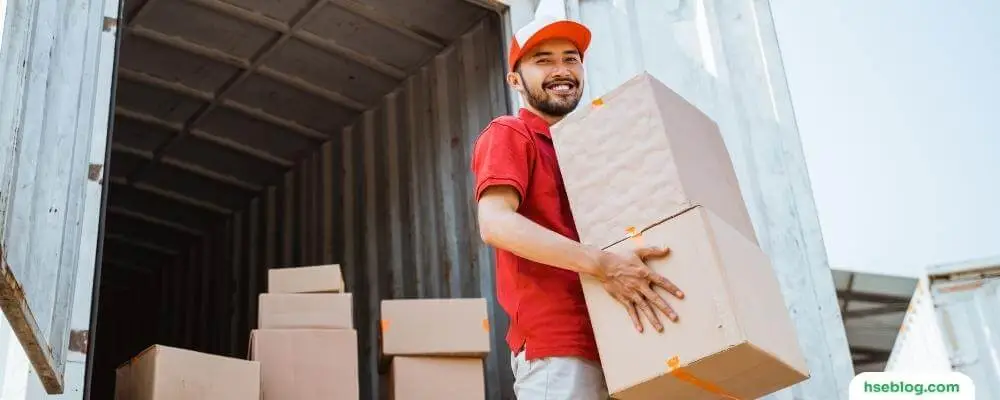Lifting and handling tasks are common in many workplaces, and they can be associated with a range of hazards and risks that can lead to injuries, accidents, or even fatalities. As a result, it is essential for workers and employers to be aware of these hazards and take appropriate measures to prevent them.
In this blog, we will discuss 9 common hazards and risks associated with lifting and handling tasks, including musculoskeletal disorders, slips, trips, and falls, falling objects, crushing injuries, overexertion, equipment failure, poor visibility, manual handling in confined spaces, ergonomic hazards, and inadequate training. By understanding these hazards and taking appropriate measures to prevent them, workers and employers can create a safer work environment and reduce the risk of injuries and accidents related to lifting and handling tasks.
The Importance Of Proper Lifting And Handling Techniques
Proper lifting and handling techniques are crucial for preventing injuries, especially those related to the musculoskeletal system. When lifting heavy objects or performing tasks that require repetitive motion, the body is put under stress, and if not done correctly, it can lead to painful conditions such as strains, sprains, and even herniated discs.
Here are some reasons why proper lifting and handling techniques are important:
- Preventing injuries: Using proper lifting techniques reduces the risk of injury to your back, shoulders, and other parts of your body. It helps you avoid straining your muscles, tearing ligaments, or injuring your spine.
- Reducing fatigue: When you lift heavy objects or perform tasks that require repetitive motion, it can be tiring. Using proper lifting techniques can help reduce fatigue, which can lead to better productivity.
- Improving efficiency: Using proper lifting and handling techniques can make the task more efficient, allowing you to complete it more quickly and with less effort.
- Maintaining proper posture: Proper lifting techniques help you maintain good posture, which is important for your overall health. Poor posture can cause pain and discomfort, and it can also contribute to chronic conditions such as back pain.
- Enhancing safety: Using proper lifting techniques is essential for maintaining safety in the workplace. It can help prevent accidents and injuries, which can lead to lost productivity and increased costs.
In summary, proper lifting and handling techniques are critical for preventing injuries, reducing fatigue, improving efficiency, maintaining proper posture, and enhancing safety. By following these techniques, you can help ensure that you stay healthy and productive, both at work and in your everyday life.

Hazards And Risks Associated With The Lifting & Handling
Lifting and handling activities are a common part of many workplaces, but they can pose significant hazards and risks if not carried out safely. Here are 9 hazards and risks associated with lifting and handling:
1. Musculoskeletal Disorders
Musculoskeletal disorders (MSDs) are injuries and disorders that affect the musculoskeletal system, which includes muscles, tendons, ligaments, joints, and nerves. They can result from various factors, such as overexertion, repetitive motions, awkward postures, and contact stress.
- Overexertion: Lifting loads that are too heavy or beyond a worker’s capacity can cause excessive strain on the muscles, tendons, and ligaments. Over time, this can lead to micro-tears, inflammation, and chronic pain.
- Repetitive motions: Performing the same lifting or handling tasks repeatedly can cause wear and tear on the musculoskeletal system, resulting in repetitive stress injuries such as tendonitis, bursitis, or carpal tunnel syndrome.
- Awkward postures: Lifting and handling tasks often require workers to bend, twist, or reach in ways that stress their joints and muscles. These awkward postures can lead to strains, sprains, and other MSDs over time.
- Contact stress: Pressure from hard or sharp objects, such as gripping a tool tightly or resting a limb against a sharp edge, can cause localized damage to soft tissues, nerves, or blood vessels, leading to MSDs like carpal tunnel or thoracic outlet syndrome.
MSDs, such as the back, shoulder, and knee injuries, can have a significant impact on a worker’s quality of life and ability to perform their job. In severe cases, these injuries can lead to chronic pain, reduced mobility, and long-term disability.
To prevent MSDs, employers should provide adequate training in proper lifting techniques, maintain a safe work environment, and encourage workers to use appropriate equipment and tools. Workers should also be aware of their physical limits and practice good body mechanics to minimize the risk of MSDs.
2. Slips, Trips, And Falls
Slips, trips, and falls are some of the most common causes of workplace injuries, particularly during lifting and handling tasks. These accidents can occur for a variety of reasons, such as wet or slippery surfaces, cluttered work areas, or unstable surfaces. When workers lose their balance while lifting or handling materials, the consequences can be serious, leading to injuries, property damage, or even fatalities.
- Wet or slippery surfaces: Spills, leaks, or wet floors can make surfaces slippery, increasing the risk of workers slipping while carrying loads. This can result in falls, dropped objects, or loss of control over the materials being lifted or handled.
- Cluttered work areas: Obstacles in walkways, such as tools, equipment, or debris, can cause workers to trip or lose their footing while lifting or handling materials. Tripping can lead to falls, dropped loads, and injuries to the worker or others in the area.
- Uneven or unstable surfaces: Working on irregular or unstable surfaces, such as ramps, steps, or gravel, can make it difficult for workers to maintain their balance while lifting or handling loads. This increases the risk of falls and accidents, particularly if the worker is carrying a heavy or awkwardly shaped load.
- Inadequate footwear: Wearing inappropriate footwear, such as shoes without slip-resistant soles or proper support, can contribute to slips, trips, and falls during lifting and handling tasks.
- Poor visibility: Insufficient lighting or obstructed views can make it difficult for workers to see potential hazards on the floor, increasing the likelihood of slips, trips, and falls.
To minimize the risks associated with slips, trips, and falls during lifting and handling tasks, employers should maintain a clean and organized work environment, provide adequate lighting, and ensure that workers wear appropriate footwear.
Workers should be trained to recognize and avoid potential hazards, as well as follow safe lifting and handling techniques. Proper use of equipment, such as hand trucks or forklifts, can also help reduce the risk of accidents related to slips, trips, and falls.

3. Falling Objects
Falling objects can be a significant hazard during lifting and handling tasks, particularly when loads are not secured properly or workers do not use appropriate equipment or techniques. Objects that fall from height can cause severe injuries, including head trauma, fractures, or even fatalities. Here are some common reasons why falling objects can occur during lifting and handling tasks:
- Improper lifting techniques: If workers do not use proper lifting techniques, such as keeping the load close to the body and bending at the knees, they can lose control of the object, causing it to fall or slip.
- Inadequate securing of the load: When loads are not properly secured to a lifting device, such as a crane or hoist, they can shift or fall during transport or handling, posing a risk to workers below.
- Poorly maintained equipment: Equipment that is not well-maintained, such as worn-out slings or frayed cables, can fail during lifting and handling tasks, causing loads to drop.
- Overloading equipment: If workers exceed the maximum weight capacity of equipment, such as forklifts or cranes, the equipment can tip over or fail, causing the load to fall.
- Unsafe work practices: Workers who engage in unsafe work practices, such as horseplay or standing underneath suspended loads, increase the risk of being struck by falling objects.
To prevent injuries caused by falling objects during lifting and handling tasks, employers should provide proper training on safe lifting techniques and the use of equipment. Workers should also follow manufacturer guidelines for equipment operation and regularly inspect equipment and tools for signs of wear or damage.
Appropriate personal protective equipment, such as hard hats and safety shoes, should be worn when working where falling objects are a hazard. Regular housekeeping to remove clutter and debris from work areas can also help reduce the risk of falling objects.
4. Crushing Injuries
Crushing injuries are a significant hazard during lifting and handling tasks and can result in severe or even fatal injuries. These injuries occur when workers are caught between a load and a fixed object, such as a wall or a piece of machinery, and are squeezed or crushed. Here are some common causes of crushing injuries during lifting and handling tasks:
- Improper use of equipment: Workers who use equipment, such as forklifts or cranes, improperly or without proper training, can cause the load to move unexpectedly and crush them.
- Lack of communication: Failure to communicate effectively between workers can lead to workers being trapped between a load and a fixed object.
- Inadequate equipment maintenance: Equipment that is not well-maintained can malfunction, causing loads to drop or move unpredictably, which can lead to crushing injuries.
- Poorly stacked or secured loads: Loads that are stacked or secured improperly can shift or fall unexpectedly, potentially crushing workers.
- Working in confined spaces: Workers who are required to work in confined spaces or tight areas, such as crawl spaces or narrow aisles, may be at risk of being crushed by loads or equipment.
To prevent crushing injuries during lifting and handling tasks, employers should provide proper training on the use of the equipment and emphasize the importance of communication and situational awareness. Equipment should be inspected regularly, and any issues or malfunctions should be addressed promptly.
Workers should also follow safe lifting techniques and be aware of the potential hazards associated with the load they are lifting or handling. Appropriate personal protective equipment, such as hard hats and safety shoes, should be worn when working where crushing injuries are a hazard.

5. Overexertion
Overexertion is a common hazard associated with lifting and handling tasks and can result in a range of negative health effects for workers. When workers lift loads that exceed their capacity or use poor lifting techniques, they can experience overexertion, which can lead to fatigue, dehydration, or heat stress. Here are some common reasons why overexertion can occur during lifting and handling tasks:
- Lifting loads that are too heavy: Workers who lift loads that are too heavy for their physical capacity can strain their muscles and joints, leading to overexertion.
- Repetitive motions: Repeatedly lifting or handling objects over time can lead to muscle fatigue and overexertion, particularly if workers do not take adequate rest breaks.
- Working in hot or humid conditions: When workers perform lifting and handling tasks in hot or humid environments, they can become dehydrated, leading to fatigue, heat exhaustion, or heat stroke.
- Poor nutrition or hydration: Workers who do not eat a balanced diet or drink enough fluids can become fatigued more easily, making them more susceptible to overexertion.
- Poor fitness or conditioning: Workers who are not physically fit or conditioned may have reduced endurance or strength, making them more susceptible to overexertion.
To prevent overexertion during lifting and handling tasks, employers should provide proper training on lifting techniques and ensure that workers are not required to lift loads that exceed their physical capacity. Workers should also take adequate rest breaks, particularly during repetitive tasks, and be encouraged to maintain good nutrition and hydration.
Employers should also provide a safe work environment that includes adequate ventilation and climate control to prevent heat-related illnesses. Finally, workers should be encouraged to maintain good physical fitness and conditioning through exercise and stretching programs to reduce the risk of overexertion during lifting and handling tasks.
6. Equipment Failure
Equipment failure is a common hazard associated with lifting and handling tasks and can result in serious accidents and injuries. When lifting equipment such as cranes, hoists, or forklifts are not maintained properly or are misused, they can fail, causing loads to drop or equipment to tip over, potentially causing accidents. Here are some common reasons why equipment failure can occur during lifting and handling tasks:
- Inadequate maintenance: When lifting equipment is not inspected or maintained regularly, it mechanical problems can develop that can cause equipment failure during lifting and handling tasks.
- Misuse of equipment: Workers who use lifting equipment improperly or do not follow manufacturer guidelines can cause the equipment to fail, leading to accidents.
- Overloading equipment: When workers exceed the maximum weight capacity of lifting equipment, such as forklifts or cranes, it can cause the equipment to tip over or fail, potentially causing accidents.
- Poor training: Workers who have not received proper training on the use of lifting equipment may not be aware of the risks associated with misuse or overloading, increasing the likelihood of equipment failure and accidents.
- Environmental factors: Environmental factors, such as wind or uneven terrain, can cause lifting equipment to fail during handling tasks, potentially causing accidents.
To prevent equipment failure during lifting and handling tasks, employers should ensure that lifting equipment is inspected regularly and maintained in good working order. Workers should be trained to use equipment properly and follow manufacturer guidelines for equipment operation.
Equipment should not be overloaded, and workers should be aware of the risks associated with environmental factors that can cause equipment failure. Finally, workers should be encouraged to report any problems or concerns with equipment to their supervisors immediately to prevent accidents or injuries.

7. Poor Visibility
Poor visibility is a common hazard associated with lifting and handling tasks, and it can make it difficult for workers to assess the risks associated with their tasks accurately. When lighting is inadequate or views are obstructed, workers may not be able to see potential hazards or may have difficulty determining the best way to lift or handle materials. Here are some common reasons why poor visibility can occur during lifting and handling tasks:
- Inadequate lighting: Poor lighting in work areas can make it difficult for workers to see potential hazards or determine the best way to lift or handle materials.
- Obstructed views: When workers’ views are obstructed by equipment, materials, or other objects, they may not be able to see potential hazards or may have difficulty determining the best way to lift or handle materials.
- Poor weather conditions: When weather conditions such as fog, rain, or snow reduce visibility, it can be challenging for workers to assess the risks associated with lifting and handling tasks accurately.
- Limited space: When workers are required to lift or handle materials in limited space, it can be difficult for them to see potential hazards or assess the risks associated with their tasks accurately.
To prevent accidents related to poor visibility during lifting and handling tasks, employers should ensure that work areas are well-lit and free from obstacles that could obstruct workers’ views. Workers should also be trained to identify potential hazards and use appropriate lighting, personal protective equipment, or other measures to ensure they can see potential hazards and accurately assess the risks associated with their tasks.
In cases where limited space is a factor, employers should consider using specialized equipment or adjusting work processes to minimize the risks associated with poor visibility.
8. Inadequate Training
Inadequate training is a common hazard associated with lifting and handling tasks, and it can lead to a higher risk of injuries for workers. When workers do not receive proper training on lifting and handling techniques, they may not be aware of the risks associated with their tasks or how to lift and handle materials safely. Here are some common reasons why inadequate training can occur during lifting and handling tasks:
- New workers: Workers who are new to a job or a company may not have received adequate training on the specific lifting and handling tasks they are required to perform.
- Lack of training resources: Employers who do not provide adequate training resources, such as written manuals or training videos, may leave workers without the information they need to perform lifting and handling tasks safely.
- Inconsistent training: Workers who receive inconsistent or incomplete training on lifting and handling techniques may not have a clear understanding of how to lift and handle materials safely.
- Language barriers: Workers who do not speak the language in which training is provided may have difficulty understanding the information provided, leading to inadequate training.
To prevent injuries related to inadequate training during lifting and handling tasks, employers should provide proper training on lifting and handling techniques to all workers, including new hires. Training should be consistent and include information on the specific lifting and handling tasks workers are required to perform.
Employers should also provide adequate training resources, such as written manuals or training videos, and consider providing training in multiple languages to accommodate workers who do not speak the language in which training is provided. Workers should also be encouraged to ask questions and seek clarification if they are unsure about how to lift and handle materials safely.

9. Ergonomic Hazards
Ergonomic hazards are common hazard associated with lifting and handling tasks, and they can lead to awkward postures and repetitive strain injuries for workers. When workstations, tools, or equipment are poorly designed, workers may be required to adopt awkward postures or use repetitive motions that can lead to musculoskeletal injuries. Here are some common reasons why ergonomic hazards can occur during lifting and handling tasks:
- Poorly designed workstations: Workstations that are not designed to accommodate the physical needs of workers can force workers to adopt awkward postures or positions while performing lifting and handling tasks.
- Inadequate tools or equipment: Tools or equipment that are not designed for the specific lifting and handling tasks workers are required to perform can increase the risk of musculoskeletal injuries.
- Repetitive motions: When workers perform lifting and handling tasks that require repetitive motions, such as picking up and moving boxes or packages, they may be at increased risk of developing musculoskeletal injuries.
- Awkward postures: When workers are required to adopt awkward postures or positions to lift or move materials, they may be at increased risk of developing musculoskeletal injuries.
To prevent injuries related to ergonomic hazards during lifting and handling tasks, employers should assess workstations, tools, and equipment to ensure that they are designed to accommodate the physical needs of workers. Workers should also be trained on proper lifting and handling techniques and encouraged to take rest breaks and stretch to prevent the development of musculoskeletal injuries.
Employers should also provide tools and equipment that are designed for the specific lifting and handling tasks workers are required to perform and consider automation or mechanization of lifting and handling tasks where appropriate to reduce the risk of musculoskeletal injuries.
Finally, workers should be encouraged to report any discomfort or pain they experience while performing lifting and handling tasks, and employers should take appropriate measures to address these concerns promptly.

Lifting Heavy Objects Risk Assessment
Lifting heavy objects can pose significant risks to an individual’s health and safety. When assessing the risks associated with lifting heavy objects, the following factors should be taken into consideration:
- The weight and size of the object: The heavier and larger the object, the greater the risk of injury.
- The frequency of lifting: Regularly lifting heavy objects increases the risk of injury.
- The distance of the lift: The greater the distance of the lift, the greater the risk of injury.
- The posture and technique used to lift the object: Poor posture and technique can increase the risk of injury.
The individual’s physical condition and health status: Individuals with pre-existing injuries or medical conditions may be at greater risk of injury.
- The environment in which the lifting takes place: The presence of obstacles or uneven surfaces can increase the risk of injury.
- Based on the assessment of these factors, the following measures can be taken to reduce the risks associated with lifting heavy objects:
- Use mechanical aids, such as forklifts or cranes, to lift heavy objects whenever possible.
- Avoid lifting heavy objects alone, and instead ask for assistance.
- Ensure that the object being lifted is stable and secure before attempting to lift it.
- Use proper lifting technique, which involves bending the knees and keeping the back straight.
- Take frequent breaks and avoid lifting heavy objects for prolonged periods of time.
- Ensure that the environment in which the lifting takes place is clear of obstacles and has a stable and even surface.
By implementing these measures, the risks associated with lifting heavy objects can be significantly reduced, leading to a safer and healthier workplace.
Conclusion
Lifting and handling tasks are common in many workplaces, and they pose significant hazards and risks to workers. The physical demands of these tasks can lead to musculoskeletal disorders, injuries, and accidents if not properly managed. It is important for employers to conduct thorough risk assessments, provide appropriate training and equipment, and implement safety measures to minimize the risks associated with lifting and handling.
Workers also have a responsibility to follow safe lifting practices, report any hazards or injuries, and take care of their physical health to prevent work-related injuries. By prioritizing safety and implementing effective risk management strategies, employers can create a safe and healthy work environment, and protect their employees from harm.

